|
|
|
Zanjan (48° 28' longitude and 36° 40' latitude), where the Zanjan University is located, is an ancient city. In Ptolemy’s Geography, the city is referred to as Aganzana. It is said that the Sassanid king, Ardeshir Babakan, reconstructed the city and called it Shahin but later it was renamed Zangan,,of which the present name is the arabicized form.
Before the Mongol invasion, Zanjan was a flourishing city and its famous fortress, Sar-Jahaan, was quite well known. The city and its fortress, however, were completely destroyed during the Mongol invasion.
Zanjan now has a population of over 260,000. The city is connected to Tehran through a transit highway and railway. There are five train services to Tehran and back covering the 350 km distance roughly in 3:30 to 4 hours.
In the past, Zanjan was a center for traditional and religious education. At present, the institutions of higher learning in the city comprise Zanjan University, with about 3000 full-time students at Bachelor’s and Master’s levels, The Islamic Azad University, with about 6000 full-time and part-time students at post-diploma and Bachelor’s levels, the newly established University of Medical Sciences, and the Institute for Advanced Studies in Basic Sciences.
|
|
|
Natural and Historical Sights of Interest
Zanjan is a green and pleasant city. The Zanjan-rood, (the Zanjan River) which originates near the city of Sultanieh, runs past Zanjan. On the banks of this river there are large orchards and natural forests, such as the Forest Park of Zanjan, providing pleasant places of recreation for the inhabitants.
To the north of the province, there is the Taarom Valley with a moderate climate and overlooking the Ghizil Ozan river. Along the Zanjan-Tehran Motorway, there are places of interest including the beautiful plains of Sultanieh, 40 kilometers east of Zanjan; Saa-in Ghal ’e, 60 kilometres away; and Khorram-darreh and Ab-har, 80 kilometers away. These regions with green hills and huge orchards have a cool and refreshing climate.
Zanjan province, whose towns are located at the foots of high mountains offers plenty of attraction to mountain-climbers. The existence of natural caves such as Kataleh-Khor in Khodaa-bandeh 80 kilometers east of Zanjan, attracts many visitors every year. In winter, the Paapa ’ee ski resort, only 30 kilometers from Zanjan, is covered with snow for three months offering skiers an opportunity to enjoy themselves.
There are also historical buildings in the province. The Sultaanieh Dome, an important historical monument built under Sultan Uljaitoo in the fourteenth century A.D. is in the process of restoration. The explorers who visited the Dome in its early good shape considered it as one of the most interesting and important structures built in the Islamic era.
The congregational mosque of Zanjan and the city’s ancient bazaar are also among the places of interest. In addition to these, the shrines of Chalabi Oghli and Mullah Hassan Kaashaani near Soltanieh and that of Seyed Ebrahim in Zanjan which are a few hundred years old can also be cited among the places of interest. [TOP]
|
|
|
Sultanieh City
This city is located in 35 km of Zanjan. It is said to have been built in a Meadow on the outskirts of an older city by the order of king Arqun, the Mongol Ilkhan. Later named Sultanieh, it was built with a citadel and watch towers and walls made of green stone. Soltan Mohammad Khodabandeh ( Oljaitu ) made the city his capital in the year 704 Hejria
|
|
Sultanieh Dome
Some 800 years of antiquity, Sultanieh Dome is the country’s largest ancient sight. It is also the world’s third-largest historical site proceeded by Italy’s Santa Maria Delfiore of Florence and Turkey’s Saint Sufia Mosque, of Istanbul. The Dome is 48.5 meters high and 25.6 meters in diameter. Registered by the UNESCO as historical and archeological-significant monument. Sultanieh Dome is frequently visited by numerous Iranian and foreign tourists.
As commanded by Oljaitu, a famous Mongolian ruler also known as Soltan Mohammad Khodabandeh, The Dome was built in nine years as 704 lunar Hejira. Decorative skills applied in the construction of this dome mark the perfection of Iranian architectures, the plaster and tile working of this dome is unique in terms of inscriptions, designs, the Quranic verses and painting.[TOP]
|
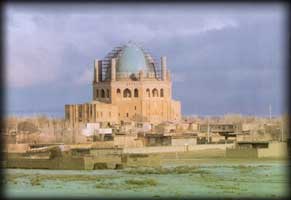
|
|
|
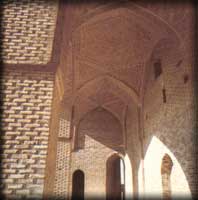
|
Jame-Mosque
Jame-Mosque and school which is the locally famous as Seyed and Soltani mosque is located at the ancient texture of the Zanjan province. This splendid and historical mosque was constructed by "Abdollah Mirza" the son of king Fathali Shahe Qajar when he was ruling in Zanjan 1242 A.H. The architecture and design of this long-lasting and fantastic monument was made of the four Eivans. Each Eivan was allocated to theological science and education center. The fourfold Eivan has 48 meters long and 35 meters width. In this mosque 22 small chambers were set up for dwelling of the religious scholar. [TOP]
|
|
|
Rakhtshooi Khaneh(wash-house)
Wash-house monument lies at the historical texture of the city compiling with the time in the year 1347 Lunar Hijira. This place was used for washing clothes by women around the city. The water of the building has been provided with the well water and underground water tables of the Haji Mir Baha-e-din Ghalejee .This ancient building is being used as Zanjan Anthropological Museum. [TOP]
|
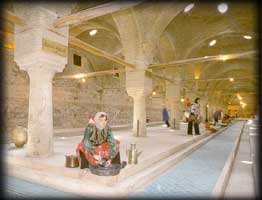
|
|
|

|
Traditional Bazaar
The construction of the traditional Bazaar collection began during the rule of the king Agha Mohammad Khan Qajar and finished in the king Fat Ali Shah era (1213 A.H).
In 1324 Hejira several cultural centers including mosque ,traditional public baths and caravansaries added to the collection. The Bazaar collection divided the ancient texture of the city in the form of the one direct line entitled upward and downward Bazaar ,into two northern and southern sections. In this collection there are certain guilds of trade union such as goldsmith, cloth-dealer ,hat maker as well as Zanjan handicrafts union.
Zanjan Bazaar from the old times has acted as the heart of the city. It has also played a major role in the providing social, religious and sanitary needs for the people. [TOP]
|
|
|
Historical and Ancient Bridges
In the south of the province, there is a long river called Zanjan-Rood which is now famous as Zanjan chay .Across the saeed river, some historical and well-known bridge including Seyed Mohammad bridge ,Mir Baha-e-din bridge and Sardar bridge have been constructed during the reign of the Qajar dynasty. [TOP]
|
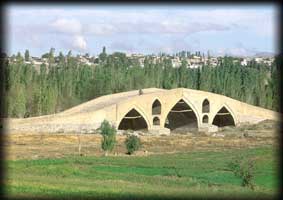
|
|
|
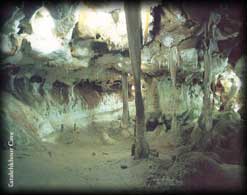
An interior view of Kataleh Khor Cave
(Photo by Mehdi Khoshnevis)
|
Kataleh Khor A Most Beautiful, Mysterious Cave
By Farzaneh Shokri
Kataleh Khor Cave, one of the most beautiful in the world, is located 165 km southwest of Zanjan. The entrance to the cave is situated on the southern slopes of the 2,000-meter high Saghizloo Mountain.
The cave has flat walls with high ceiling and archeologists estimate the age of the cave at 30 million years. At least 12,000 to 13,000 visitors go to Kataleh Khor Cave each year.
The entrance to Kataleh Khor resembles a crevice at the beginning and culminates in a triangular arch. Archeologists have made the entrance bigger and it currently stands at 1.5 meter high.
The first labyrinth is 400 meters from the entrance of the cave. It is expansive and has a high ceiling.
After the labyrinth, the gallery, channels and passages have taken shape gradually becoming larger or smaller. The area of the labyrinth is 200-300 square meters. Chains of galleries are separated from each other. Some of them are open ended while others have narrow strip linking to other passages or labyrinths.
Some of the strips have yet not been paved while others remain undiscovered. The floor of the labyrinths and channels are uneven and have formed through the ages with the dissolution of stones and shaping of new waterways.
Sometimes the waterways are deep and wide in the labyrinths and passages and there are crystallized stalactites which are beautiful and have taken shape from top to the bottom. They are spectacular.
Those who have been through the cave say that the visibility inside the cave extends to 700 meters.
Some potteries dating back to 2000 BC have been found in the cave.
The second type of potteries obtained from the cave is reddish to brown in color. They can be compared with those belonging to the third century AD.
The third type of potteries obtained from the cave is modern and are of no historical value.
At the end of one of channels of the first floor, there is a skeleton of four-legged animal which has turned into ’Calcite’ in the form of monster.
In 1951, a veteran mountaineer from Zanjan, Asadollah Jamali discovered the mysterious cave and a team visited it the following year.
Since 1993, structure have been constructed in the vicinity of the cave to host visitors. Special lights and projectors have been installed to help visitors to get a glimpse of the unknown world inside the Cave. [TOP]
|
|
| |